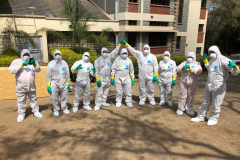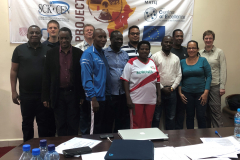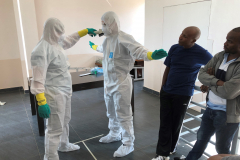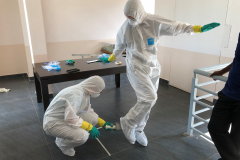The week of Table-Top exercises (TTX) and Field exercises (FX) was organised in Nairobi, Kenya from 26 to 30 August 2019. Nine national experts (including two females) from different agencies from Burundi, DRC and Seychelles participated in the exercises that were organised at the Kenyan Radiation Protection Board (RPB) radioactive storage facility in Nairobi. As agreed with the participants beforehand, the exercises were provided in the French language. Three instructors from the Consortium (ENCO, SCK-CEN and STUK) were also present to conduct these exercises.
For each FX/TTX, an information note (containing the exercise objectives, a short description of the scenario and required infrastructure and equipment) was prepared. Furthermore, the exercises’ agreements and agendas were provided to all participants one week before the event.
For the TTXs, a document called “Guide for players” containing the exercise objectives and the scenario including the injects was prepared. In addition, at the beginning of each exercise, a briefing was made by the instructors, discussing the objectives, the details of the scenario and practical agreements. After each exercise, the instructors lead a debriefing with the participants, to provide recommendations for improvement. In general, there was a good cooperation between group members, leading to constructive discussions and information exchange. The majority of the participants were very positive about the exercises and gave good feedback, including a few recommendations.
The exercises were organized as follows: day 1 – preparation day, day 2 – table top exercise on illicit trafficking of Radioactive and Nuclear (RN) material, day 3 – field exercise on illicit trafficking of RN material, day 4 – table top exercise on cross border investigation of RN material and day 5 – field exercise on cross border investigation of RN material.
Before the initiation of the exercises, a preparatory day was organized to welcome the participants, introduce the week of exercises, and check all the administrative and logistics arrangements, including the location(s), the detection equipment, the radioactive sources, and other arrangements to make sure that the exercises would be implemented as planned. It was also needed to provide safety and security briefings. The instructors also presented and distributed the SOPs that were prepared for the exercises. The instructors also presented the HotSpot software that was used in the following days by the participants. The Consortium experts took the time to explain the radiological assessment part and requested the participants during all exercises to perform some calculations (e.g. of expected radiation doses on i
ncident site) and to discuss about the results obtained.
The table-top exercise on illicit trafficking of RN material took place on the second day. The participants were first given the chance to practice with the measurement equipment. The exercise started with a briefing by the Consortium experts, with three phases for the scenario (threat phase, emergency phase and recovery phase). The participants were split in two mixed groups. The scenario involved a case of illicit trafficking on land, where a suspect vehicle, containing radioactive material, crashed. After each group discussion, a plenary session was held, including also a press release by the participants, facilitated by the instructors. Last part of the exercise was a press conference, in which one group was asked to come forward and give a short press statement, after which ‘journalists’ from the public were allowed to ask questions to the group members. There was a good cooperation between group members, leading to constructive discussions and information exchange. It was observed that the radiological assessment was a difficult part for the participants.
The third day, the field exercise on illicit trafficking of RN material took place, based on the same scenario as for the first table-top exercise. Firstly, the instructors did a practical session on donning and doffing of Personal Protection Equipment (PPE). The field exercise itself started with a briefing by the Consortium experts, introducing the exercise objectives, the scenario and practical agreements for the FX. Then, the participants organized themselves for the field exercise: they chose a commander, divided the different tasks and prepared themselves to go to the field site. At the field site, they dressed up in PPE and started with the exercise. Participants went into the field site and did the following tasks: donning of PPE, cordon the area, source monitoring, nuclide identification, personal contamination check, doffing of PPE, reporting of measurements, and develop a recovery strategy. In general, the exercise went well: the participants were able to perform all activities in a satisfactory way. A debriefing was held at the end of the exercise to collect the feedback of the participants and to provide recommendations based on the observations made by the Consortium experts during the field exercise. During the debriefing, the instructors gave some recommendations for improvement, related to knowledge of the SOPs and organisation in the field. In general, there was a good cooperation between group members, leading to constructive discussions and information exchange.
The fourth day, a table-top exercise on cross border investigation of RN material took place. The objectives and tasks were similar to the ones of the table-top exercise on illicit trafficking of RN material, but with a different scenario, i.e. an investigation and discovery of RN material at the border. The aim was to organize the relevant response to a radiological emergency situation, here investigating and discovering the smugglin
g of stolen RN material at the border between Burundi and DRC. The exercise started with a briefing by the Consortium experts, introducing the exercise objectives and the scenario, which consisted of 3 phases (threat phase, cross border investigation phase and maintaining the cross-border investigation phase). Participants were divided in two groups: one group played the DRC, while the other group played the neighbouring country (Burundi). For each phase, the participants were requested to cover the following aspects: radiological assessment and advices, decision making on actions (protection, investigation, …) to be implemented, required procedures and their implementation (including practical aspects), information and communication. After the group discussion, following each insert, a plenary session was held, facilitated by the instructors. The last part of the exercise was a press conference, in which one group was asked to come forward and give a short press statement, after which ‘journalists’ from the public were allowed to ask questions to the group members. The participants very much liked the interaction between the two countries. There was a good cooperation between group members, leading to constructive discussions and information exchange.
The fifth day was dedicated to the field exercise on the cross-border investigation of RN material, using the same scenario as for the table-top exercise on the fourth day. The exercise started with a briefing of the emergency situation, the objectives of the exercise and on the procedure for vehicle check from IAEA TECDOC-1312. In the field, the participants were well organized: they chose a site commander and had a clear task division for the group. Consequently, almost all sources were recovered at the field site. At the end of the field exercise, a debriefing was conducted to obtain the feedback from the participa
nts and to provide the feedback from the Co
nsortium experts.
On the last day, a debriefing of the full week was performed with the participants. The feedback collected in writing but also orally during the debriefing clearly indicated that this week of exercise was very useful for all participants an
d that all participants gained significant expertise through these exercises. The participants indicated that the balance between practical and theoretical aspects was very good and the coordination of the exercises by the Consortium experts was also very good. In addition, the participants provided the following recommendations: extend the time for such exercises, use local experts as facilitators and make many calculation exercises. The Consortium experts recommended the participants to organize similar exercises at national or regional level with the relevant stakeholders to further improve their preparedness to face such emergencies.





